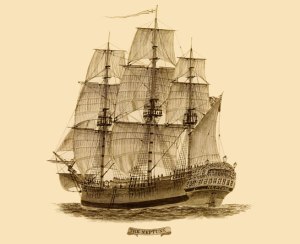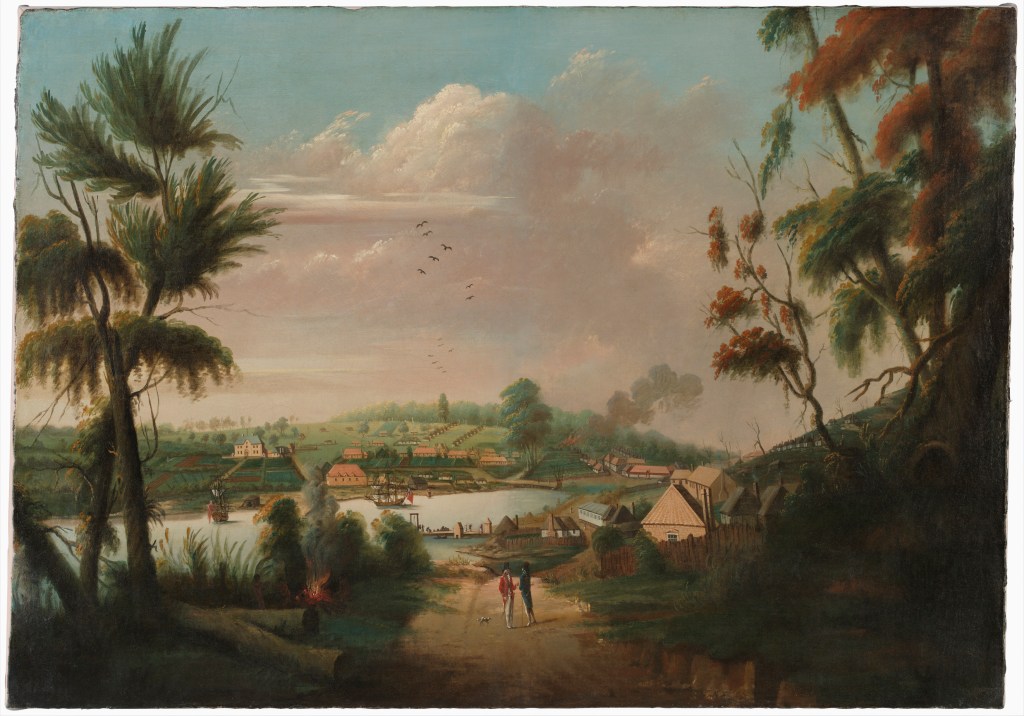The Neptune – the ‘Hell Ship’ of the ‘Death Fleet’

Week 43 OF 52 ANCESTORS CHALLENGE
PROMPT: TRANSPORT
The ship Neptune, under contract to former slave traders, arrived in Sydney Cove on 28 June 1790, one of the six ships in the Second Fleet that had been sent to the new penal colony of New South Wales. The ship’s human cargo of convicts, some dead and many others sick or dying, included two of my maternal 4 x great grandmothers, the 17 yo Elizabeth Rymes (1774-1841) and the 19 yo Kezia Brown (1771-1854). They had been transported to Australia on what became known as the ‘Hell Ship’ for its part in one of the dark chapters in Australian history. [1]

Like most working class women in Georgian England, Elizabeth and Kezia led extremely difficult lives. By the time Elizabeth was fifteen she was living with a John Moore in Spitalfields, one of London’s slums.[2] Both women had committed minor crimes to survive and both were found guilty . When they heard their judges pass the dreaded sentence “Transported to parts beyond the Seas’ it would have been impossible for Elizabeth and Kezia to predict the horrors of their voyage.[3]
Eyewitness accounts painted a devastating picture of that arrival.
The landing of those who remained alive despite their misuse upon the recent voyage, could not fail to horrify those who watched.
SYDNEY COVE CHRONICLE, 30th June, 1790 [4]
Reverend Samuel Johnson*, the Chaplain of the First Fleet wrote a graphic account of the state of the surviving Second Fleet convicts,
I beheld a sight truly shocking to the feelings of humanity, a great number of them laying, some half, others nearly quite naked, without either bed or bedding, unable to turn or help themselves…Spoke to them as I passed along, but the smell was so offensive that I could scarcely bear it…. The landing of these people was truly affecting and shocking; great numbers were not able to walk, nor to move hand or foot; such were slung over the ship side in the same manner as they would a cask, a box, or anything of that nature.
Reverend Richard Johnson, 1790 [5]
Neptune, together with three other ships of the Second Fleet, Surprize, Scarborough and the store ship Justinian sailed from England on 19th January 1790, six months after the departure of the domed Guardian and the Lady Juliana, infamously known as ‘The Floating Brothel’..[6] The Neptune had been contracted to take 424 male and 78 female convicts from England to the new colony of New South Wales. Donald Trail, the Neptune’s captain had commanded a slave ship and was described by many as a sadist. Elizabeth Macarthur described him in her diary as “a perfect sea-monster”. The voyage took 160 days. [7 ]

Mortality rates
The unprecedented mortality rate for the voyage was one death to every 3.1 convicts. One hundred and forty -seven men and eleven women from the human ‘cargo’ were dead.
The First Fleet (1787-88) arrived in NSW with a mortality rate of 5.4%. The Second Fleet arrived in NSW with a mortality rate of 40%. It’s no surprise the Second Fleet was known as ‘The Death Fleet and that Neptune is known as the ‘Hell Ship’..
This mortality rate, one that would be the highest in the history of transportation, was so shocking, even by the punitive standards of the late 1700s, that discussions were held in the British parliament:
Out of 500 passengers on board the Neptune but 42 were able to crawl over the ship’s side; the rest were carried and eight out of every ten died at Sydney Cove. The detail of the sufferings of these wretched convicts … were equal to any endured in the slave ships.
sir Charles Bunbury’s Resolutions Respecting convicts for transportation 1793, Parliamentary history of england [9]
Female convicts
Neptune was the only one of this group of ships in the Second Fleet to transport female convicts and the Navy Board issued orders stipulating that the women were to be kept separate and not abused or ill-treated. The women were unchained and housed in a section of the upper deck and had more liberties than Neptune‘s male convicts who were confined in filthy conditions, receiving inadequate rations and chained together in ‘barbarous’ irons. [10]
While the female convicts were certainly better off than their male counterparts, this came at a real cost to every woman on the ship. Unfortunately it is only too easy to understand what young women like Elizabeth and Kezia were forced to do just to survive the voyage.
At night, however, the ship’s company invaded the rooms of the women, whom they carried off to their own quarters’
‘Affair of the Hell Ship Neptune’, Sydney Morning Herald, 10 Feb. 1945, p.8. [11]

A direct north general view of Sydney Cove … 1794 . Dixson Galleries, State Library of New South Wales
Causes
The barbaric conditions and resulting desperately high mortality rates of the Second Fleet were a direct result of the privatisation of the fleet. The First Fleet had been an expensive but effective exercise. All aspects of the expedition were closely monitored by Governor Phillip. Importantly, the ships stopped three times along the way, to ensure supplies of fresh food and water.
In order to cut costs the Second Fleet, operations were contracted out.
- Neptune, along with Scarborough and Surprize, was chartered by slave traders Camden, Calvert & King at a considerably lower rate than Richards who charted the balance of the Second Fleet
- Contractors bid on fixed-price per head basis, with the contract given to the lowest bidder.
- Contractors were paid for the number of people who boarded the ships in Britain NOT for number who arrived
- There was no incentive for the contractors to treat the prisoners with care.
- Contractors were able to sell any leftover provisions at the end of the voyage. Ruthless captains like Trail withheld food from the prisoners
- Protections that were in place for convict transportation to America prior to the War of Independance were missing from the procedures for transportation to Australia
William Hill, newly appointed to the New South Wales Corps 9see London Gazette below), was severely critical of conditions for convicts and troops on the transport ships. He wrote that the conditions in the slave trade were better than the Second Fleet.
“The more they can withhold from the unhappy wretches, the more provisions they have to dispose of on a foreign market, and the earlier in the voyage they die the longer they can draw the deceased’s allowance for themselves;
William Hill , second captain, New South Wales Corps [12]

Outcomes
Despite an outcry in London after details became public, the Navy Board did not impose any financial penalty on the contractor. Incredibly the same company brought out the Third Fleet in 1791. However, changes had been made to contracts and policy. Incentives were put in place to encourage contractors to keep convicts alive by paying bonuses, thereby keeping the death rate quite low.[13]
Postscript
Donald Trial, master of the ship Neptune and his chief mate were tried at the Old Bailey in 1792 for murder. Both men were acquitted in less than three hours.
The Neptune was destroyed by fire in Capetown in 1796.
Despite Elizabeth Rymes and Keziah Brown‘s early life of crime, conviction and transportation on the “Hell Ship’ of the ‘Death Fleet’ both women prospered in the young colony. Both became matriarchs of large families with members in every area of Australian society.
*Reverend Richard Johnson married my 4 x great grandparents Elizabeth Rymes (Neptune) and Matthew James Everingham (Scarborough, First Fleet) on 13 March 1791
Australia’s current Prime Minister is a direct descendant of Kezia Brown, that young convict .woman

Endnotes
[1]Free Settler or Felon, ‘Convict Ship Neptune 1790’, https://www.jenwilletts.com/convict_ship_neptune_1790.htm, Accessed 22 October 2019.
[2] Old Bailey Online, ‘ John Moore, Elizabeth Rymes’, https://www.oldbaileyonline.org/browse.jsp?id=t17891028-23&div=t17891028-23&terms=Rymes#highlight, Accessed 25 October 2019
[3] NSW State Archives & Records, ‘Sentenced beyond the Seas: Australia’s early convict records’, https://www.records.nsw.gov.au/archives/collections-and-research/guides-and-indexes/sentenced-beyond-the-seas-australias-early, Accessed 22 October 2019.
[4] WikiTree, ‘Second Fleet to Australia, 1790’, https://www.wikitree.com/wiki/Space:Second_Fleet%2C_Australia%2C_1790, Accessed 22 October 2019.
[5] news.com.au. ‘ Australia’s tragic beginnings: The grotesque story of The Second fleet’, https://www.news.com.au/national/nsw-act/news/australias-tragic-beginnings-the-grotesque-story-of-the-second-fleet/news-story/0ad2523ddc1053ebab3d54c636ecd9ee, Accessed 21 October 2019
[6] City of Sydney, ‘Lady Juliana’, https://dictionaryofsydney.org/entry/lady_juliana, Accessed 26 October 2119.
[7] Free Settler or Felon, ‘Convict Ship Neptune 1790’, https://www.jenwilletts.com/convict_ship_neptune_1790.htm, Accessed 22 October 2019.
[8] IFHAA Shipping Pages, ‘The Convict Death Fleet’, http://www.historyaustralia.org.au/ifhaa/ships/2ndfleet.htm, Accessed 21 October 2019.
[9] Free Settler or Felon, ‘Convict Ship Neptune 1790’, https://www.jenwilletts.com/convict_ship_neptune_1790.htm, Accessed 22 October 2019
[10] Dictionary of Sydney, ‘Neptune’, https://dictionaryofsydney.org/entry/neptune#ref-uuid=34ea9b4f-da53-949c-8e66-6f0955ebd44f, Accessed 21 October 2019.
[11] George MacKaness, ‘ Affair of the Hell Ship Neptune’, The Sydney Morning Herald, 10 February 1945, p.8.
[12] news.com.au. ‘ Australia’s tragic beginnings: The grotesque story of The Second fleet’, https://www.news.com.au/national/nsw-act/news/australias-tragic-beginnings-the-grotesque-story-of-the-second-fleet/news-story/0ad2523ddc1053ebab3d54c636ecd9ee, Accessed 21 October 2019.
[13] Free Settler or Felon, ‘Convict Ship Neptune 1790’, https://www.jenwilletts.com/convict_ship_neptune_1790.htm, Accessed 22 October 2019


It’s a terrible story. What makes it worse for me is that I haven’t heard about the Hell Ship before. Hopefully “Australian History” these days is not just about the Rum Rebellion etc.
LikeLiked by 1 person
Simply horrifying! Thank you for your excellent blog post (and source citations) on this subject.
LikeLiked by 1 person
Another fantastic post! I have learned a great deal about the personal aspect of the transportation of convicts from Britain to Australia reading your posts. To imagine these young women, who were convicted of what we consider minor crimes, could survive the horrific voyage of nearly 6 months and then go on to thrive is really something. I wonder if Kezia could imagine that one of her descendants could rise to the highest office in her new country. Amazing. Thanks for sharing.
LikeLiked by 1 person
Quite a shocking story. I lived in Alice Springs for 3 1/2 years and was able to visit Sydney and see historical sites but my grasp of Australian history is still limited. You’ve expanded my knowledge considerably with your blog.
LikeLike